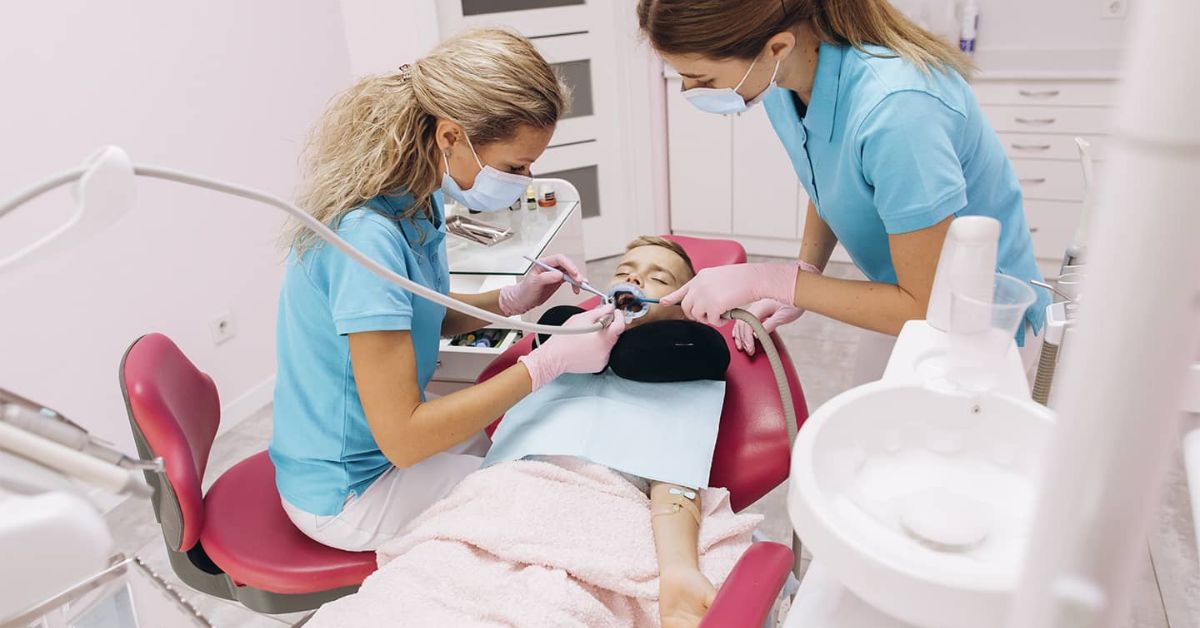For many children, the thought of visiting the dentist can be overwhelming. Dental anxiety is common among young patients, and in cases where extensive procedures are required, sedation dentistry is often considered. Parents naturally worry about whether sedation dentistry is safe for children. Understanding how it works, the risks involved, and the safeguards in place can help families make informed decisions about their child’s dental care.
Understanding Sedation Dentistry for Children
Sedation dentistry involves using medication to help a child relax during dental treatment. It is not the same as general anesthesia; in most cases, children remain conscious but calm. Depending on the procedure, sedation may range from mild relaxation to deeper levels of calmness. Common methods include nitrous oxide (laughing gas), oral sedatives, and IV sedation administered under strict monitoring.
Why Dentists Recommend Sedation Dentistry for Kids
There are several reasons why sedation is suggested for children. If a child experiences extreme dental anxiety, has a strong gag reflex, or requires complex treatment such as multiple fillings, sedation helps make the process smoother. Sedation also benefits children with special healthcare needs who may find it difficult to sit still for long dental procedures.
Types of Sedation Commonly Used in Pediatric Dentistry
Dentists carefully select the type of sedation based on the child’s health and the complexity of the treatment. The most widely used options include:
-
Nitrous Oxide Sedation: A safe and mild method often used for routine treatments.
-
Oral Sedation: Taken as a pill or liquid to provide a deeper level of relaxation.
-
IV Sedation: Used in more extensive treatments, monitored closely by dental professionals.
-
General Anesthesia: Reserved for special cases where full unconsciousness is necessary.
Each method is accompanied by rigorous safety checks and monitoring protocols to minimize risks.
Safety Precautions in Pediatric Sedation Dentistry
Parents often worry about the safety of sedation, but modern dentistry has established strict guidelines to protect young patients. Dentists receive advanced training in sedation techniques, emergency management, and patient monitoring. Continuous observation of heart rate, oxygen levels, and breathing ensures that any adverse reaction is addressed immediately.
Dental professionals are also required to stay updated with certifications, sometimes by enrolling in programs such as live dental CE courses, which focus on the latest standards in sedation safety. These practices help ensure that children are cared for in the safest environment possible.
Comparing ACLS vs BLS in Pediatric Dental Sedation
In pediatric dental care, providers must be prepared for emergencies. The difference between ACLS vs BLS is important to understand. Basic Life Support (BLS) training ensures that dental staff can respond to immediate breathing or cardiac issues. Advanced Cardiovascular Life Support (ACLS) goes a step further by equipping professionals with skills to handle more complex emergencies. Both play vital roles in ensuring safety during sedation dentistry for children.
Risks and Considerations for Parents
While sedation dentistry is generally safe, parents should be aware of potential risks. These may include nausea, drowsiness, or mild allergic reactions. In rare cases, complications may arise if a child has an underlying medical condition. This is why a thorough pre-procedure assessment is crucial. Parents should share their child’s medical history and current medications with the dentist to reduce risks.
The Role of Specialized Training in Sedation Dentistry
Not all dental professionals are qualified to administer deep sedation. Many undertake specialized education such as IV sedation courses for dentists, which prepare them to manage more advanced sedation cases safely. These courses train dentists in patient selection, dosage calculation, emergency preparedness, and post-sedation care. Parents can feel reassured knowing their child’s dentist has completed this type of professional training.
Renewing Licenses and Meeting Continuing Education Standards
Dentists must regularly update their certifications and licenses to maintain compliance with safety standards. Programs such as the renew Texas dental license requirement ensure that dental professionals remain knowledgeable about the latest sedation protocols. This continuous education guarantees that children are receiving care from practitioners who are up to date with modern practices.
Recovery and Aftercare Following Sedation
After the procedure, children are monitored until the sedation wears off. Mild drowsiness and grogginess are normal, but most children recover quickly. Parents should follow dentist-provided instructions, such as allowing rest, avoiding heavy meals, and ensuring proper hydration. In most cases, children return to their normal activities within a day.
Benefits of Sedation Dentistry for Children
Sedation offers multiple advantages beyond just managing anxiety. It allows dentists to complete treatments efficiently, reducing the number of visits. For children who struggle with fear or sensitivity, sedation helps build positive dental experiences that carry into adulthood. Parents often find that their children develop greater trust in dental professionals after experiencing care in a calm and stress-free manner.
Frequently Asked Questions
Is sedation dentistry safe for all children?
Sedation is safe for most children when administered by trained professionals. However, dentists evaluate each child’s medical history to ensure it is appropriate.
What type of sedation is best for children?
Nitrous oxide is the most common choice because of its safety and fast recovery. More complex procedures may require oral or IV sedation.
How do dentists monitor children under sedation?
Dentists use advanced monitoring tools to track heart rate, oxygen levels, and breathing throughout the procedure.
Can sedation dentistry affect future dental visits?
Yes, in a positive way. Children who undergo sedation often feel less fear during future appointments, making dental care easier long-term.
What should parents do before the procedure?
Parents should provide the dentist with complete medical information and follow fasting or preparation instructions as recommended.
Conclusion
Sedation dentistry can be a safe and effective way to help children receive the dental care they need without fear or discomfort. With strict safety protocols, specialized training, and continuous monitoring, parents can feel confident that their children are in capable hands. Choosing a dentist who meets professional standards and continues their education in sedation techniques ensures the highest level of safety.

